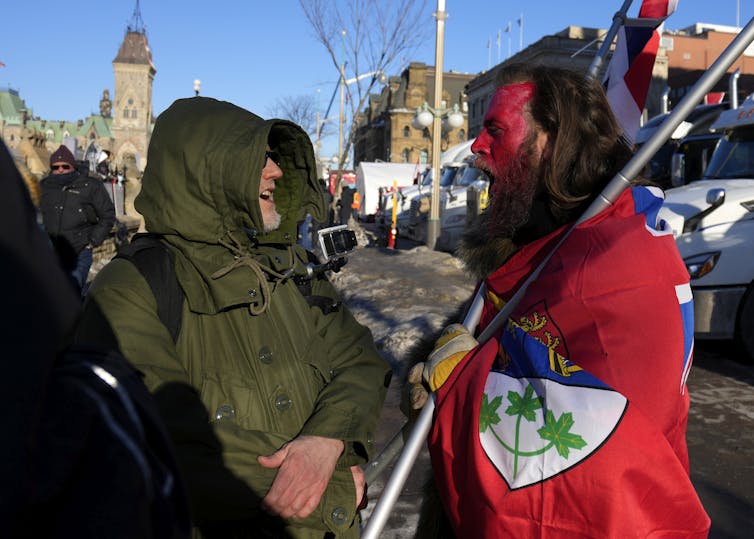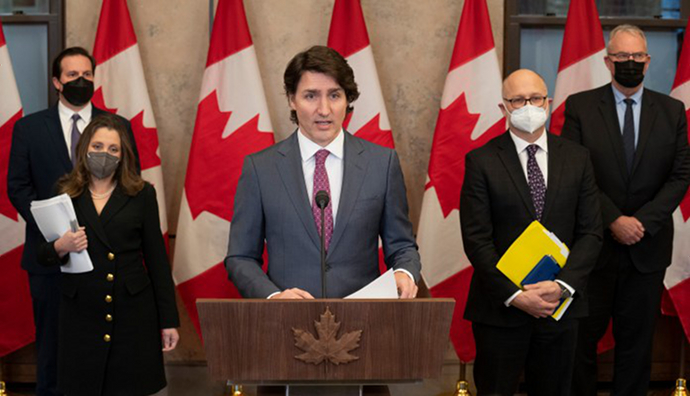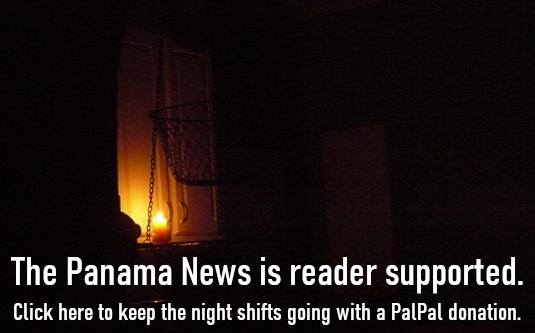Canadian Prime Minister Justin Trudeau, surrounded by key members of his cabinet, announces his government will invoke the Emergencies Act. Photo by Adrian Wyld — The Canadian press.
Canada in crisis: Why Justin Trudeau has invoked the Emergencies Act to end the protests by truckers
by Jack L. Rozdilsky, York University, Canada
Canadian Prime Minister Justin Trudeau has invoked the Emergencies Act in an effort to quell the protests by truckers and other groups opposed to measures aimed at preventing the spread of COVID-19. The federal government has never before acted to implement this once-obscure piece of disaster and emergency legislation.
Trudeau has suggested the additional tools the Emergencies Act provides for will allow the federal government to manage situations as they emerge, take extraordinary actions that are time-limited, have specific geographic bounds and deploy a measured use of out-of-the-ordinary expansive governmental powers.
“This is about keeping Canadians safe, protecting people’s jobs and restoring confidence in our institutions,” Trudeau said in a national address Monday.
Prime Minister Justin Trudeau responds to reporters’ questions after invoking the
Emergencies Act in response to the so-called freedom convoy’s occupation of Ottawa.
Canada is still in the midst of the COVID-19 global pandemic emergency. At the time of Trudeau’s announcement, 35,470 Canadians had died of COVID-19 since the beginning of the pandemic.
Never been invoked
The Emergencies Act of 1988 is part of the Revised Statues of Canada. Such legislation is reserved for use under the most extreme emergencies or existential threats. In more than 30 years, no Canadian government has determined that any disaster — natural or man-made — has created such a grave threat to the nation.
The act’s legislation names examples of emergencies that may rise to the level of top concern. Public welfare emergencies are what most people would consider as disasters, including natural phenomena and man-made catastrophes. Public order emergencies consist of various threats from civil disorder — the current occupation of Ottawa being an example. In addition, aspects of international emergencies and warfare can be addressed within the context of the Emergencies Act.
The legislation means that additional extraordinary government powers can be applied to manage an extreme emergency. These include additional layers of security for specific locations and critical infrastructure, people can be compelled to render essential services with compensation and the RCMP — Canada’s national police force — can be used to enforce municipal laws.
In the case of the current protests in Ottawa and other parts of the country, an additional new and significant aspect affects the financial support mechanisms for the ‘freedom convoy’ occupation. The methods and instruments of such financial support will now come under closer security in accordance with a broadening of Canada’s anti-terrorism financing rules.
War Measures Act
The shadow of history is important here as Trudeau stresses he is not using the invocation of the Emergencies Act to call the Canadian military onto the streets to confront citizens.
It’s an essential point for him to make: in 1970, Trudeau’s father, Pierre, invoked the War Measures Act in one of the most controversial decisions of his 15-year tenure as prime minister. The older Trudeau brought the military into the streets during the October Crisis after a series of terrorist attacks perpetrated by the separatist group known as the Front de libération du Québec.
Prime Minister Pierre Elliott Trudeau announces the War Measures Act in response to the 1970 October Crisis, when members of the FLQ kidnapped Québec’s Deputy Premier Pierre Laporte.
The War Measures Act dates back to 1914. It was intended to give the Canadian government extra powers during times of war, invasion and insurrection. Due to real and perceived injustices related to use of the act, it was repealed in the 1980s. One of those injustices was that the War Measures Act facilitated the internment of nearly 22,000 Japanese Canadians living in British Columbia during the Second World War.
When the Emergencies Act succeeded the War Measures Act in 1988, it introduced changes regarding how the federal government can use extraordinary powers in times of crisis. Those changes include forcing cabinet to seek Parliament’s approval for new emergency laws, and requiring any emergency actions to take place in a manner consistent with the provisions of the Canadian Charter of Rights and Freedoms.
The Charter is the most recognized part of Canada’s Constitution. It guarantees the rights of individuals by enshrining those rights, and puts certain limits on them.
Trudeau stressed that by using the Emergencies Act, the government was “not suspending fundamental rights or overriding the Charter of Rights and Freedoms. We are not limiting people’s freedom of speech. We are not limiting freedom of peaceful assembly. We are not preventing people from exercising their right to protest legally. We are reinforcing the principles, values and institutions that keep all Canadians free.”
In the coming days, Parliament will begin an unprecedented process of legislatively enacting emergency powers. It is not guaranteed that Parliament will concur with all of the provisions of the implementation of the Emergencies Act as tabled by the Trudeau administration.
 A confrontation between a ‘freedom convoy’ protester yelling ‘freedom’ and a
A confrontation between a ‘freedom convoy’ protester yelling ‘freedom’ and a
person opposed to the occupation. Photo by Justin Tang — The Canadian Press.
All disasters are political
The historic invocation of the Emergencies Act — due to the actions of a small group of people — begs the question: what comes next?
First, we will see numerous parliamentary procedures in Ottawa starting immediately with the specific details of what the implementation of the Emergencies Act will actually mean.
Second — perhaps more importantly to those in Ottawa and elsewhere whose lives are being negatively impacted by the continued disruptions — the act will swiftly allow for action to bring the immediate crisis to an end.
There will be changes in how people will be allowed to gather. There will also be designations of new zones with enhanced security protocols at locations with critical infrastructure, government operations, border crossings and airports.
Additional services will be provided to spots under occupation, such as downtown Ottawa. Specifically, services such as heavy towing could be brought to bear on the situation in ways not available before.
Third, the invocation of the Emergencies Act sends out the symbolic message that Canada is treating the current anti-mandate blockages and occupations with the utmost seriousness. As Ottawa approaches the third week of the occupation, this action should have taken place much earlier.
In the end, all disasters are political. There will be an examination of why it took so long to invoke the Emergencies Act. But in the meantime, Canada is telegraphing to the world that public order will be maintained — and the government can take action to quell this crisis of social origin.![]()
Jack L. Rozdilsky, Associate Professor of Disaster and Emergency Management, York University, Canada
This article is republished from The Conversation under a Creative Commons license. Read the original article.
Contact us by email at fund4thepanamanews@gmail.com
To fend off hackers, organized trolls and other online vandalism, our website comments feature is switched off. Instead, come to our Facebook page to join in the discussion.
These links are interactive — click on the boxes













